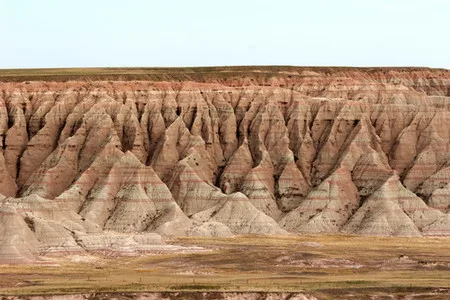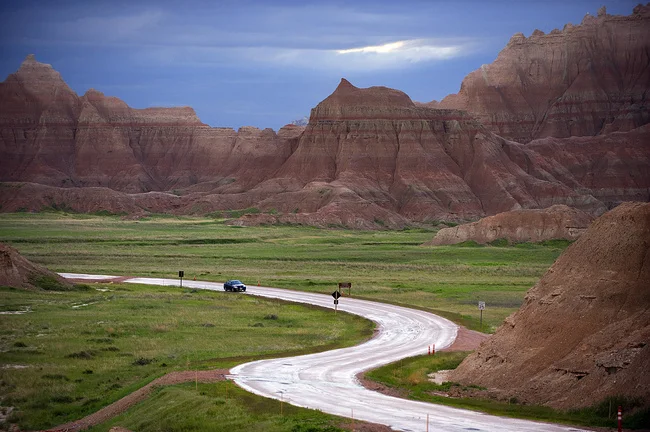History
The Badlands National Park, which literally means park of bad lands) is a national park of the United States located in the southwest of the state of South Dakota, north of the Great Plains. It is a natural park that offers eroded landscapes (buttes, pinnacles and arrows) and meadows and is also rich in paleontological sites, since within the park there are numerous fossils from the Oligocene period (23 to 35 million years before our era) that they allow scientists to study the evolution of certain mammal species such as horses, sheep, pigs and rhinos.
 |
| Badlands National Park History |
The wall
They call it The Wall. It stretches for hundreds of miles (160 kilometers) across the dry plains of South Dakota—a natural barrier—huge ridges to the landscape, sculpted into fantastic pinnacles and illicit ravines by the forces of water.
Those who pass through the upper prairie a few miles to the north don't even know it exists. Those that cut across the low prairie to the south, however, are not to be missed, instead rising above them like a petrified, ruined city skyline.
The Badlands Wall, much of which remains within the boundaries of Badlands National Park, may not conform to everyone's idea of beauty, but no one can deny its theatrics. It has been compared to a huge stage, colorful, dramatic, and not very real. Water, the main player at this point, has been carving into rocks for the last half million years or so, carving away a full inch (three centimeters) or more in some places each year. But there have been other players, too. Beasts with names like titanothere and archaeotherium once roamed here, fossilized bones can be found by the hundreds.
And today the Badlands Wall serves as a backdrop for bison, pronghorn, and bighorn sheep, as well as the million human visitors that pass through the park each year.
 |
| Badlands National Park History |
Fauna
The most notable animal species in the park are: the Coyote, the Porcupine, the Canadian Mouflon, the Bobcat, the American Picaza, the North American Bison, the Prairie Pitcher, the Black-tailed Prairie Dog, the Fox swift and the black-footed Polecat.
Mammals
Due to its steppe vegetation, the park is home to herds of herbivores such as the Hémione Deer (Odocoileus hemionus), the Pronghorn (Antilocapra americana), or the North American Bison (Bisonte bison). In addition to this large herbivore, there are numerous rodents that feed on the grasses and other vegetables in the meadows. The most common rodents in the park are the Desert Rabbit (Sylvilagus audubonii), the Lesser Tamia (Eutamius minimus), the 13-banded Souslik (Spermophilus tridecemlineatusi), the Black-tailed Prairie Dog (Cynomys ludovicianus), the Wild Mouse (Peromyscus maniculatus), the Grasshopper Mouse (Onychomys leucogaster) which is carnivorous, the Bushy-tailed Rat (Neotoma cinerea), the Meadow Vole (Microtus ochrogaster), the Pennsylvania Vole (Microtus pennsylvanicus), the Common Mouse (Movidos musculus) and the Porcupine (Erethizon dorsatum). The most common predatory mammal is the Coyote (Canis latrans)
15 species of birds have been recorded in the park. The most common species are the Turtle Dove (Zenaida macroura), the Skylark (Eremophila alpestris), the Rustic Swallow (Hirundo rustica), the American Black-billed Woodpecker (Pica hudsonia), the Bunting (Ammodramus savannarum), the Shoulder-padded Thrush (Agelaius phoeniceus) and Sturnella ( Sturnella neglecta ). The Canada Crane (Grus canadensis), although also abundant (especially during the migration period), does not nest within the park.5 Other vertebrates
The park is home to various species of amphibians (salamanders, toads and frogs), but the most common are Pseudacris triseriata, the Leopard Frog (Rana pipiens) and the Bufo woodhousii. If lizards are rare in the park, there are, on the contrary, several species of snakes.
Flora
The park is 50% covered with mixed meadows. Numerous species of herbs and flowering plants have been recorded there, as well as some trees and shrubs that survive in the semi-arid climate. The park administration also fights against about 70 invasive species, brought there accidentally or voluntarily by European settlers.
The mouflon, bison, fox, and polecat were actually reintroduced to the park after their extermination in this region. The mouflon disappeared from this region for about 40 years: the last known specimen in the Badlands was hunted in 1926, and in 1964 the species was reintroduced to the park. The bison disappeared from this area in the 1880s and was reintroduced in 1963, after more than 80 years of eclipse. The black-footed polecat is the most endangered terrestrial mammal in North America. Considered extinct in the wild in the 1970s, a small wild population in Wyoming was discovered in 1981. By crossing with captive individuals, individuals were obtained that were reintroduced in very specific areas (that is, protected and presenting a good population of meadow dogs, the polecat's favorite prey).
National Monument
A national monument since 1939, the Badlands acquired the South (Fort) Outbuilding in 1976, adding a new dimension to the drama. This vast tract of land belongs to the Oglala, and one of their most sacred places is now preserved within. It was here, at Mesa Fortress, that the end of the Ghost Dance took place in 1890, just weeks before more than 150 Lakota were massacred at Wounded Knee, 25 miles (40 kilometers) to the south.
